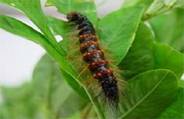Management:
- Dig out and destroy the pupae from the field bunds and shady spots prior to summer rains
- Set up 3 to 4 light traps and bonfires immediately after receipt of rains, after sowing in the rainfed season to attract and kill the moths and also to know brood emergence
- Collect and destroy gregarious, early instar larvae on lace-like leaves of intercrops such as redgram and cowpea
- Collect and destroy egg masses in the cropped area. Avoid migration of larvae by digging a trench 30 cm deep and 25 cm wide with perpendicular sides around the infested fields
- Apply any one of the following insecticides at 25 kg/ha (for young caterpillars)
- Phosalone 35 EC 750 ml/ha in 375 l of water
- Dichlorvos 76 EC 627 ml/ha
Virus multiplication
Collect medium sized larvae of Amsacta albistriga from the field and starve them over night. Make a pure suspension of virus with the nucleus culture, in water. DipCalotropis leaves in virus suspension, shade dry and feed them to starved larvae for 1 or 2 days. From third day, normal, untreated leaves can be fed to these larvae. From 5th day, the treated larvae will start dying. Virus infected larvae can be diagnosed by their pinkish ventral surface, their head hanging downwards with white body contents oozing out through ruptured body wall in the late stage. Collect the dying larvae, keep in fresh potable water for a few days, grind the larvae and filter through several layers of fine cloth and collect filtrate (Crude virus suspension). Use virus suspension obtained from 750 medium sized larvae for spraying one hectare along with a sticker 250 ml or Triton in 350 l of water. Use potable water for mixing and spray in the evening hours. |


